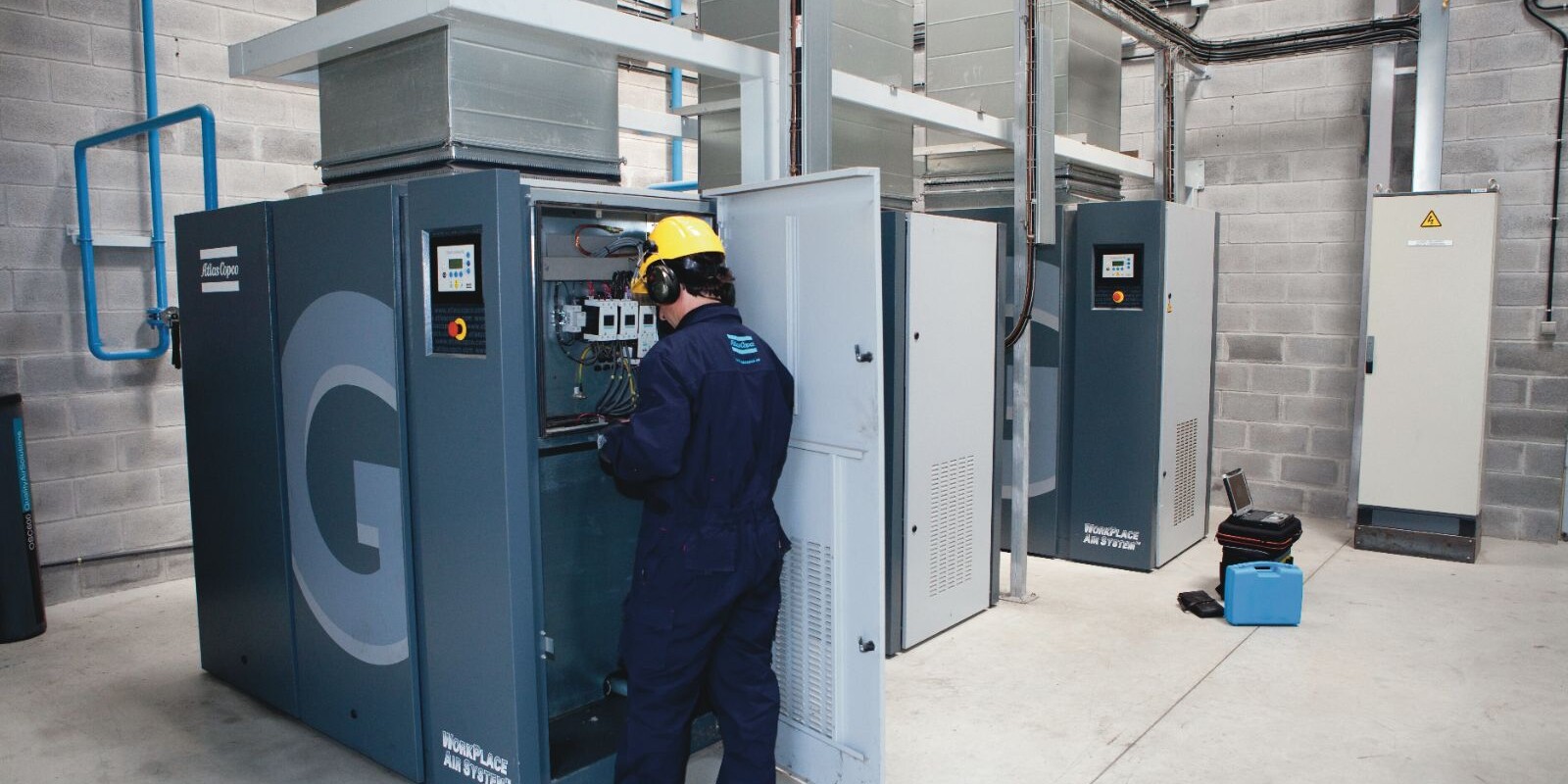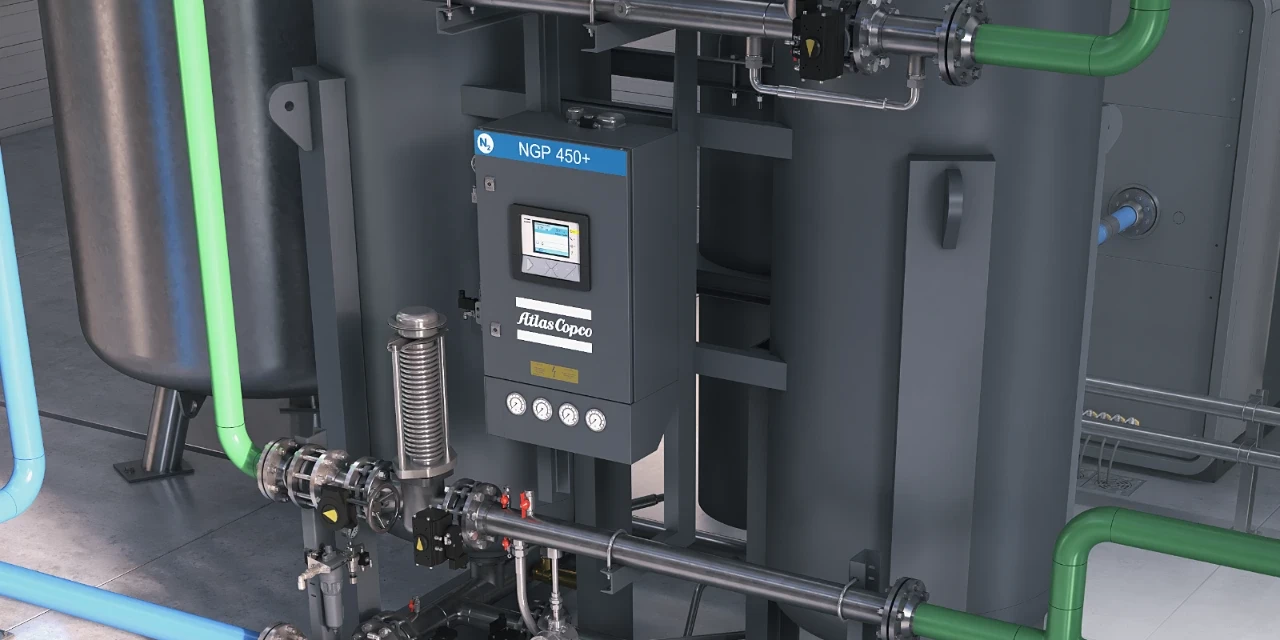Nitrogen is a vital gas for many processes and industries. Largely inert, it can be found in uses from creating clean atmospheres for welding to minimise oxidisation, to flushing out food packaging to prevent spoilage.
However the traditional method of supply, the delivery of pressurised nitrogen gas bottles, or topping up of a bulk liquid nitrogen tank, is expensive and inconvenient. Instead, on-site nitrogen generators, using compressed air to separate nitrogen from the surrounding air, are becoming increasingly popular.
How on-site generation works
Nitrogen is the largest component of air, comprising around 78% of every breath we take.
Nitrogen generation uses the different properties of nitrogen and oxygen to separate the gases. Pressure Swing Adsorption (PSA) passes compressed air through Carbon Molecular Sieves (CMS) which absorb the smaller oxygen molecules, leaving the larger nitrogen molecules. Membrane separation uses a hollow fibre membrane module which traps the nitrogen to create a constant supply.
The best option depends on your needs, but both can produce high-purity nitrogen, up to 99.5% pure using membrane separation, and up to 99.9995% pure with PSA.
The benefits of on-site nitrogen generation
Moving to on-site generation offers significant advantages over bottled gas deliveries.
- Purity management. You can manage your system to produce the precise purity you need, meaning you don’t have to pay for over-specified gas from a supplier.
- Safer. On-site production minimises the movement of high-pressure, and heavy, cylinders, in and around your premises (or indeed a liquid tanker delivering liquid nitrogen) reducing hazards.
- Environmental benefits. On-site production eliminates the need for regular deliveries, reducing the emissions and environmental impact associated with transporting heavy bottles.
- Independence. On-site production frees you from dependence on an external supplier. You can generate as much, or as little, nitrogen as you need, exactly when you need it, all without having to manage the bottles while you wait for collection and deliveries.
- Savings. Perhaps the biggest benefits are the savings. The other benefits combine to make a significant impact on your bottom line. Eliminating transport costs, reducing wastage, and saving time on managing bottle rotations all add up, and it’s common for customers to report saving up to 50% when compared to the cost of their old bottled deliveries.
Industries that can benefit from on-site nitrogen generation
Any industry that uses nitrogen in its processes can benefit from on-site nitrogen production, but there are some that particularly benefit, including:
Food and beverage processing
Nitrogen’s inert nature, and especially the lack of water vapour, makes it invaluable in processes involving food and beverages.
Ensuring that production processes do not introduce contaminants, nitrogen can also create an atmosphere for packaging. It reduces the risk of spoiling and increases the shelf-life of foods.
Pharmaceutical manufacture
Like food manufacturing, nitrogen helps by creating a clean atmosphere for processes where high purity is paramount.
As well as packaging, ensuring that medicines remain dry and unspoiled, it is useful for manufacture, where powders are often used and need to be moved in a clean and efficient way.
Metal fabrication
Nitrogen’s inert nature helps when manipulating materials.
Used as an atmosphere in processes like welding and laser cutting, it can help prevent oxidisation.
Electronics assembly
As electronics become smaller and more complex, the importance of solid and clean connections increases.
Nitrogen is used in assembly processes. Removing the risk of even microscopic participants affecting components, it also ensures clean and effective soldering.

Choosing the right nitrogen generator
Getting the right nitrogen generator depends on two factors.
Capacity needs
Both types of generation can produce significant volumes of nitrogen, but the way they work means one may be more suited.
In PSA generation, the CMS becomes saturated with oxygen. The oxygen is released when pressure is reduced, meaning constant production requires two PSA towers, so one can recharge while the other works. PSA Generators can produce up to 99.9995% purity so are better suited for high purity / low volume applications. Membrane separation, however, lets oxygen molecules permeate from the membrane, leaving mostly nitrogen molecules. These generators are normally suited for lower purity, high volume applications.
Your current use of bottled nitrogen will give you a good indication of demand and use, but don’t forget to allow for potential changes that might result from the lower cost and increased convenience of on-site production.
Purity requirements
Perhaps the most important determinant will be the purity level you need.
If you are working with electronics or pharmaceuticals, the standards are normally rigorous, and you may need to use a PSA generator which can achieve up to 99.9995% purity.
If your purity needs are lower, then both PSA and membrane generation can be calibrated to produce purities from around 90%.
In general, the lower costs and simpler systems required by membrane removal make it the better option if the highest possible purity isn’t necessary.
Busting on-site-generation myths
Many businesses continue using bottled nitrogen because of misunderstandings about on-site nitrogen generation.
MYTH: On-site generation is expensive
Many assume that nitrogen generation requires expensive specialist equipment and is costly to run. In fact, most air compressors can be used for nitrogen generation.
A sizeable proportion of bottled nitrogen costs are for bottle management and delivery, making on-site generation more cost-effective. Although there are initial costs for equipment and installation, the investment often pays for itself in 12-24 months.
MYTH: On-site generation is difficult to manage
If you already have an air compressor with sufficient spare capacity, all you need is a generator to generate nitrogen. A nitrogen generator can operate with minimal intervention.
Combined with servicing and maintenance, you’ll find that on-site generation is probably much easier than managing the ordering, movement, and storage of bottled nitrogen or organising liquid deliveries via a tanker
MYTH: On-site generation doesn’t offer control
Generating nitrogen on-site gives you total control over your supply. You can produce nitrogen on demand, ensuring that you never run out, without the need to manage deliveries and empty bottles.
However, it also gives you control over your purity. You can adjust the purity of gas you generate to your precise needs. It means you don’t have to pay for over-specified gases.
Make the move to gas generation
On-site generation is, hands-down, a better option than bottled deliveries. It gives you total control over your supply of nitrogen, helps the environment, and saves you money.
To explore your options, and discover how easy on-site generation really is, call Direct Air. We can help you discover the generator you’ll need, how it can integrate with your existing systems, and work out how much you’ll be saving from day one.






